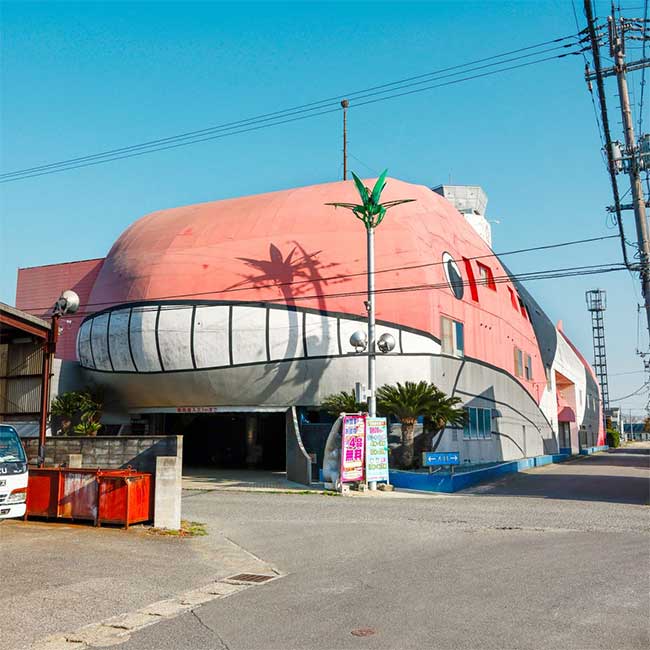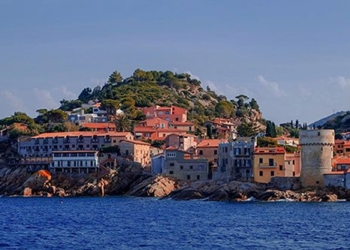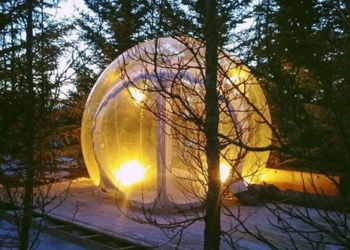With creative designs ranging from European castles to spaceships and giant whales, these hotels exemplify a break from traditional architecture while also serving as fascinating proof of the blend between conservatism and openness in Japanese society.
During a long 3,000 km journey across Japan, French photographer François Prost explored and captured unique images of “love hotels”—a distinctive cultural feature of “the Land of Cherry Blossoms.” These establishments are not just ordinary accommodations but also testaments to the creativity present in modern Japanese architecture.

Resembling a spaceship landing, the UFO Hotel in Chiba is one of the most unusual designs that the French photographer encountered during his trip. (Photo: Francois Prost/CNN)
Contrary to what many might think, these hotels are not discreet or hidden. Instead, they stand out with their playful architecture, bright colors, and unique designs that are unmistakable. Some hotels even feature heart or lip-shaped signs, with impressive names such as Hotel Passion, Hotel Joy, or Hotel BabyKiss.
“You can see spaceships, boats, and even a giant whale that looks very childlike,” Prost shared in an interview from France. Among the approximately 200 hotels he photographed, many were designed in castle styles, creating a diverse picture of contemporary Japanese architecture.
One of the quintessential examples is the UFO Hotel in Chiba, shaped like a spacecraft just landed from outer space. Another impressive establishment is the Festa Qugiela Hotel in Okayama, constructed in the form of a giant whale. These designs not only attract attention but also create a unique identity for each hotel.

Designed to resemble a whale, the Festa Qugiela Hotel in Okayama is a part of Japan’s unique architectural tradition. (Photo: Francois Prost/CNN)
The history of these love hotels dates back to discreet inns that existed centuries ago in Japan. However, their modern form began developing in 1958, when Japan enacted an anti-prostitution law.
Today, rather than being associated with illegal activities, these hotels primarily serve young couples living in small apartments or sharing homes with family. “Nowadays, they aren’t just for sexual activities. Hotels also offer various entertainment amenities like karaoke rooms,” explained photographer Prost. Guests can rent rooms by the night or choose the “kyukei” (short stays by the hour).
The unique design of love hotels began flourishing in the 1960s-1970s, when these establishments became more upscale. Meguro Emperor, one of the most famous hotels of this period, sparked a trend for buildings designed in European castle styles. Additionally, there are structures mimicking French countryside homes and even Arabian-style palaces, such as the Aladdin Hotel in Okayama, featuring a distinctive onion-shaped dome.
Despite their extravagant appearance, the designs of these hotels prioritize guest privacy. “Everything is designed to ensure you don’t pass anyone else when entering the building. Therefore, the entrance is different from the exit, and there can be one elevator going up and another going down,” the photographer explained.

The colorful Baby Kiss Hotel is located in the city of Himeji, Japan. (Photo: Francois Prost/CNN)
By the 1990s, this architectural style began to shift as hotels catered more to female clientele. Furthermore, new laws passed in the mid-1980s placed love hotels under police regulation, prompting many new establishments to adopt more refined designs to avoid being classified as love hotels.
According to hospitality industry statistics from the late 1990s, it is estimated that around 500 million visitors frequent these establishments each year. Currently, while it is difficult to pinpoint the exact number, it is estimated that over 20,000 love hotels are operational in Japan.
Although this type of hotel also appears in other Asian countries like South Korea and Thailand, they are most closely associated with Japan. Many establishments have attempted to rebrand themselves as “entertainment” or “fashion” hotels to avoid negative stereotypes.
Prost believes that these hotels reflect an interesting contrast within Japanese culture: between conservatism and the openness of society. He argues that this architecture “says much more about Japan” than the famous iconic buildings. He is currently planning to publish a photo book on this subject through a crowdfunding campaign on Kickstarter.





















































